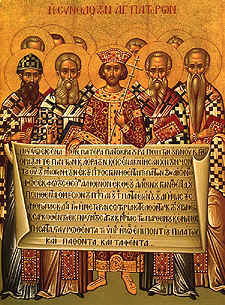LUTHER 1527 The Nicene Doctrine of the Consubstantiality of the Son with the Father


LUTHER 1527
It helps my cause that St. Paul says, “Take, eat; this is my body, which is broken for you” [I Cor. 11:24], which according to the Greek language can be understood thus: which is broken or divided or given among you, as the Scriptures call breaking bread “sharing bread.” (Cf. I Cor. 10:16, Mark 8:19, lsa. 38:7. While Luther is correct in saying that in special constructions “breaking” means sharing, he is not correct in saying that huper in I Cor. 11:24 can mean “among you.”) Similarly the words about the cup may well read in Greek and Hebrew, “This is the cup, a new testament, which is poured out among you” [Luke 22:20], as one pours wine out of a tankard for the guests. - Martin Luther
The Nicene Doctrine of the Consubstantiality of the Son with the Father.
The Nicene, Homo-ousian, or Athanasian doctrine was most clearly and powerfully represented in the East by Athanasius, in whom it became flesh and blood; and next to him, by Alexander of Alexandria, Marcellus of Ancyra (who however strayed into Sabellianism), Basil, and the two Gregories of Cappadocia; and in the West by Ambrose and Hilary.
The central point of the Nicene doctrine in the contest with Arianism is the identity of essence or the consubstantiality of the Son with the Father, and is expressed in this article of the (original) Nicene Creed: “[We believe] in one Lord Jesus Christ, the Son of God; who is begotten the only-begotten of the Father; that is, of the essence of the Father, God of God, and Light of Light, very God of very God, begotten, not made, being of one substance with the Father.”
HISTORY OF THE CHRISTIAN CHURCH Schaff Volume 3 NICENE AND POST-NICENE CHRISTIANTY A.D. 311-600
(Page 654)

0 Comments:
Post a Comment
<< Home